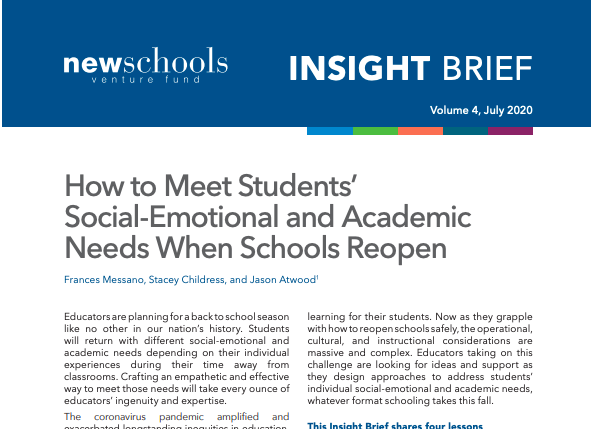By Justin Wedell, Associate Partner, NewSchools Venture Fund

Earlier this year, we released an analysis of the tools teachers said they were using most often in our 2019 survey with Gallup on “Education Technology Use in Schools.” In that analysis, we found that most teachers were using different digital learning tools, painting a picture of a highly-fragmented marketplace. We also found that elementary school teachers were more likely than their secondary school counterparts to name subject-specific digital learning tools instead of more content-agnostic platforms. As part of our follow-up survey this past summer, we were interested in how these previous trends might be shifting in the transition to distance learning.
So what’s changed in the past year?
Not a lot. Similar to 2019, many of the secondary teachers were less likely than elementary teachers to name subject-specific tools. Compared to K-5 teachers, teachers in grades 6–8 and 9–12 mentioned more content-agnostic tools that are designed to be used across subjects (e.g., Google Apps and quiz solutions) than subject-specific tools (e.g., Raz-Kids and Lexia). This orientation aligned with the relative selection priorities of teachers at different grade levels. Fifty-one percent of elementary school teachers consider a tool’s ability to “personalize learning based on students’ skill levels” to be the most important selection criterion compared to 41% of middle school teachers and 32% of high school teachers. For middle school and high school teachers leaning on more content-agnostic platforms, being “easy to use” takes on greater importance. In fact, for high school teachers, it is the most important priority. That said, content-agnostic tools did stand out more across all grade levels than in the previous year. This makes sense in the context of the shift to distance learning, as teachers have had to increase their reliance upon more general content distribution platforms to facilitate their virtual classrooms.
For one in four teachers, the digital learning tool that they used most commonly is unique to them.
One thing that has changed in 2020 is even greater fragmentation in digital learning tool selection. In 2019, only one digital learning tool was named by more than 25% of teacher respondents as one of their most often used tools for their subject. The majority of digital learning tools within each subject were only named by 5% of teachers or less, meaning that most teachers used different learning tools. In 2020, this fragmentation has increased, as no tool was named by more than 14% of teachers within a given subject. The majority of digital learning tools within each subject are now only named by 2% of teachers or less. This isn’t surprising given what we know about the transition to distance learning. It was often not perfectly-coordinated, varied extensively across school sites and classrooms, and relied upon a supply of digital tools not designed for 100% virtual use. As teachers and schools scrambled to put together new distance learning experiences, many were forced to assemble a patchwork of solutions to support their students’ needs.
Forty-two percent of parents say their confidence in the quality of education provided at their child’s school decreased over the past six months. Extensive fragmentation in tool selection may have a role in this.
This lack of coherence could be one of the reasons why parents have such negative perceptions of digital learning tools. In six of eight indicators, the majority of parents say that ed tech is less effective than non-digital tools. Forty-two percent of parents say their confidence in the quality of education provided at their child’s school decreased over the past six months. Extensive fragmentation in tool selection and the challenges this presented in implementation potentially have a role in this.
As we look ahead, we wonder if this will change as digital learning tool selection becomes more centralized and standardized. It’s important to note that this survey was conducted in the summer of 2020, a time in which the digital learning tool strategies for many classrooms were still very much in flux. As these strategies more fully crystalize throughout the rest of this school year, teachers’ most commonly used tools could consolidate. Of course, this increased fragmentation could also become the norm. As educators and families tailor their digital tool portfolios to their unique needs, some may find they favor the customization. Either way, the outcome — like much of the current education landscape — is far from settled.
For access to the report’s expanded findings, please visit the report’s homepage on our website. If you have any questions about the data or NewSchools, please contact Justin Wedell.



